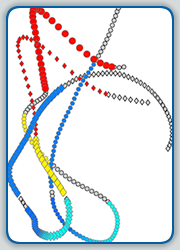Animal Spacing Behaviour: From Home Ranges to Territories
Despite the vast literature on animal space use, quantification of its causes has been elusive. Due to the intrinsic integrative nature of animal spacing behaviour, useful theoretical tools, which measure how an animal responds to the presence of a neighbouring individual as well as how it is affected by the distribution of resources, are still lacking. An important factor in shaping the degree with which neighbours share space and resources, is the social interaction between conspecifics. By building analogies with the world of eusocial insects whereby animals interact via stigmergy, i.e. communicating indirectly by modifying the (chemical) environment in which they wander, we aim to quantify how the degree of home range overlap varies as a function of the propensity of an animal to retreat from locations recently visited by other conspecifics.
Animal Search Strategies
To cope with uncertainty animals gather information that help increase the encounter of preys or food items, nest sites or mate partners. Beneficial knowledge may come in different forms from environmental cues and past experience to eavesdropping conspecifics. To best cope with the the spatio-temporal variability of the resources being searched, animals may use movement strategies that optimize information gathering. Besides the relevance of these strategies to an animal survival, understanding how different movement tactics are selected may provide innovative bio-inspired spatial search algorithm. By analysing movement trajectories of animals in the wild or in artificial arenas, we are interested in deciphering and quantify individual search strategies as a function of the information about resource availability and conspecifics’ presence.
Animal Collective Movement
Movement coordination is often observed in moving animal groups. The reasons for its appearance may be different, but the way in which is accomplished is believed to be quite general: directional alignment of an individual to one of more of its neighbours. Recent empirical and theoretical studies on pairwise characteristics of coordinated flights in echolocating bats have revealed that perceptual biases and delayed alignment are interaction mechanisms sufficient to ensure coordination while avoiding collision. Current directions aim to determine the scalability of these interaction mechanisms and the applicability to animal species with passive, e.g. vision, rather than active sensing.
Exploration of unbounded domains in swarm of robots
What is the most efficient way to coordinate groups of autonomous robots during exploration tasks, when only short-range communication and target detection capabilities are available? Evolution is there to guide us in finding bio-inspired solutions. With lessons learned from studying how animals from different taxa solve their foraging tasks, it is possible to develop distributed algorithms that reduce the spatial search oversampling between neighbouring robots. For example, an efficient method is to make the robots mimic territorial behaviour. If the external contour of the region to explore has boundaries, then employing territorial robots is a viable solution. But when the space to explore is practically unbounded, e.g. for planetary exploration, mapping of the sea floor, or large scale environmental monitoring tasks, there is an added complexity that needs to be solved. The swarm of robots needs also to remain cohesive. In this case, biology also offers potential solutions, with the self-organising capabilities of eusocial insects as a particular source of inspiration.
Spatial Ecology of Infectious Diseases
Although pathogens are passed between individuals in many different ways, the rate of transmission depends crucially on how often a susceptible and an infected individual ‘encounter’ each other. Identifying when and where transmission events occur is critical to devise effective control strategies. In the context of zoonotic diseases, the transmission of the infection between rodents carrying the Hanta virus is believed to occur mainly via direct contacts. In other cases the transmission may be mediated by a vector, e.g. an insect for the Dengue epdemic. Mediated transmission resulting from revisits of locations recently occupied by infected animals is an important transmission pathway with which badgers infect cows with Mycobacterium bovis, favouring the spread of Bovine Tuberculosis. The frequency with which animals visit the same location either simultaneously or at different moments in time-delayed encounter is one of the basic mechanism that determines if an epidemics will eventually spread. Theoretical models of epidemic propagation based on individual encounters are still in their infancy and how spatial spread depends on the social structure of an animal population is very much in need of answers.
